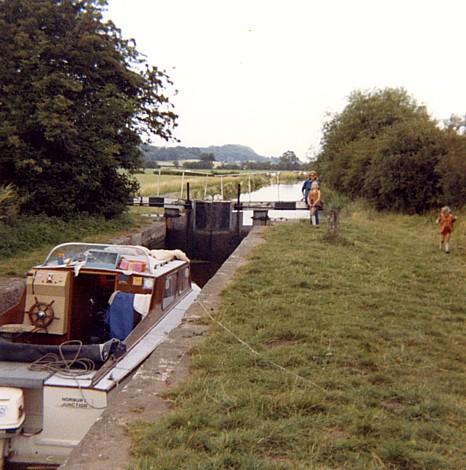
Branston Lock, showing the original paddle gear.
These narratives describe my experiences navigating the canals of the Birmingham Area during the 1970's, and in particular the BCN and Stourbridge Canals.
I used a cheap 'Instamatic' type camera to get proof of our reaching certain points on the canal system, and the quality of some of the photos regrettably leaves a little to be desired.
Starting in July 1974 we had one of our most adventurous trips. We set off on the 21st from Norbury Junction, and first headed north to the top of Adderley Locks before returning to Norbury as we had to attend the funeral of a long-standing family friend.
After the funeral we headed towards Autherley. On this occasion the stop-lock was virtually superfluous as the summit level of the Staffs & Worcs was very low. We then turned left towards Gailey.
On the way we had one of the funniest events of our travels. Shortly before Gailey we spotted a cruiser drifting down the canal. There was no response to our hail, so we decided to take the boat in tow, whereupon two faces peered through the curtains before a scantily dressed gentleman appeared. He said he had been asleep, but I fear that we had ruined a beautiful moment!
We then headed down towards Haywood Junction, where we turned right onto the Trent & Mersey, passing through Fradley and Burton before reaching the Trent at Shardlow.

Branston Lock, showing the original paddle gear. |
We carried on down to Trent Lock, had a quick trip up to Langley Mill and back, before going up the Soar to Market Harborough. We then retraced our steps to Foxton, headed up the locks and on to the Welford Arm, then via Buckby, Braunston, Coventry, and Snarestone to Fazeley. By now we had reached the 9th August, and our route home was to take us through the BCN again.
The Drayton Manor swing bridge was already open, so I could not judge how difficult it was to work - the other boat did it all. We headed up three locks before stopping for the night.
Next morning we were soon up the Curdworth flight. Petrol, milk and sausages were obtained at a shop by Minworth Bottom Lock, and soon after we encountered a novel obstruction. Some workmen had put an air line across the canal, and the only way past was to lift it over the top of the boat. We had lunch just by Bromford Road Bridge, and the children found large numbers of ripe blackberries nearby.
After lunch we soon reached Aston Locks, where two boats came down as we approached the bottom lock. Thereafter it was a steady plod upwards. It was better as the locks got closer further on. It was raining steadily all the while, but not too heavily.
There was a short respite before Farmers Bridge. We met one boat in the intervening pound, and one more in the flight. The rain got heavier and Hazel was not amused when I left her holding the boat while I went ahead to set a few, especially as it was the lock before the one under a building where she might have stayed a bit drier. By the time we reached the top three locks it was belting down.
It was now time to moor, but there was nowhere in Cambrian Wharf so we moored opposite the junction to the Main Line. We quickly found that we were in the way of a trip boat, so I moved towards Gas Street. My main memory of this was that the wind had got up and so we travelled most of the way sideways. The 35 locks that day was a new record for us.
Next morning we overslept after the exertions, so we eventually set off at about 11 am having rewatered and had the log signed by Bob Shillabeer from a boat called Petra.
This time we did all the loops - Oozells Street was not very exciting;
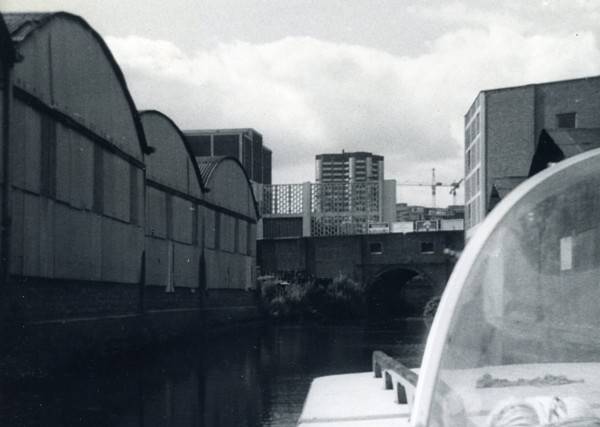
On the Oozells Street Branch, approaching Sheepcote Street Bridge. |
Icknield Port Road Wharf Loop was more interesting as a number of boats were moored there, and a BWB boat had a lock gate which must have been removed from the Smethwick flight which was closed at this time.
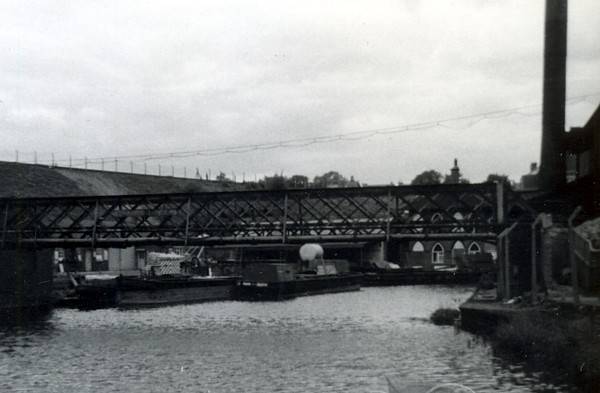
On the Icknield Port Loop, with the BWB Yard and Rotton Park Reservoir dam behind. |
The Soho Loop presented more problems. There was weed, two plastic bags on the prop, and it was very shallow in the western half of the loop. We had a short excursion up what was left of the Soho Branch, but did not risk getting too close to the rubbish near the closed Lodge Road Bridge. Back on the Soho Loop one bridge had very little parapet - it could be seen in the bridgehole. As we were going under the railway bridge just before rejoining the Main Line a train went over, which gave us all a shock as it was very noisy.
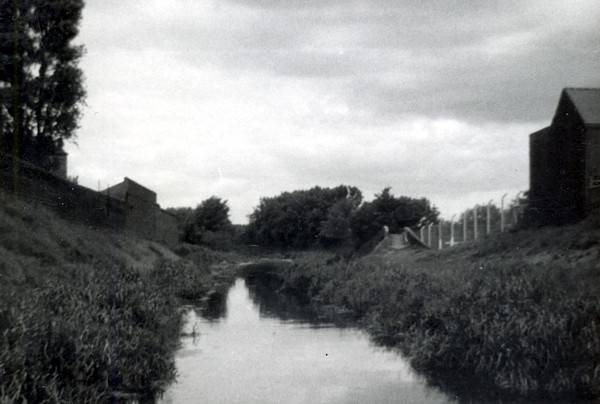
On the Soho Loop, with the Soho Branch Roving Bridge on the right. |
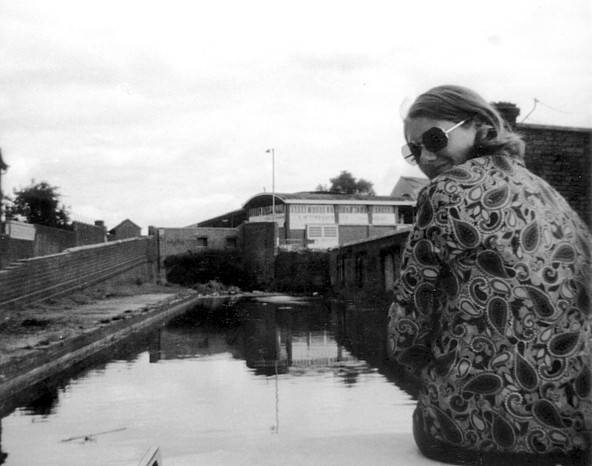
On the Soho Branch, with Lodge Road Bridge ahead. |
We proceeded on through the new Galton Tunnel, and at lunch the children found many more blackberries in the cutting.
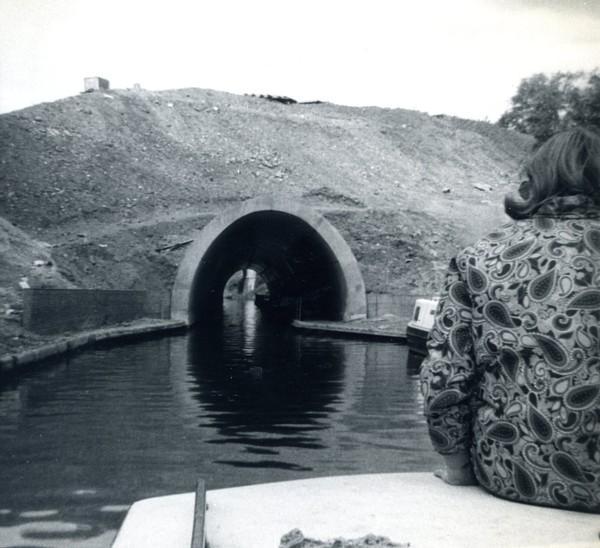
Approaching Galton Tunnel during construction of the covering embankment. |
At Pudding Green Junction we turned right, and found that the canal was very shallow, not helped by the water level being 3 inches down. At Ryders Green Junction we turned right onto the Wednesbury Canal. Unfortunately there was a nauseating smell from a nearby factory, the channel was very narrow and shallow, and the water had the colour of diluted milk, so we turned back after a quarter of a mile - the smell combined with a very real fear of damage to the hull forced us back. Since then I have always regretted not getting to the end, especially as the branch has now been shortened by a new road crossing.
Ryders Green Locks were very easy to work, although one pound was 2 feet down. A lockful of water helped. There was a tramp fast asleep in the grass by lock 6, snoring very loudly.
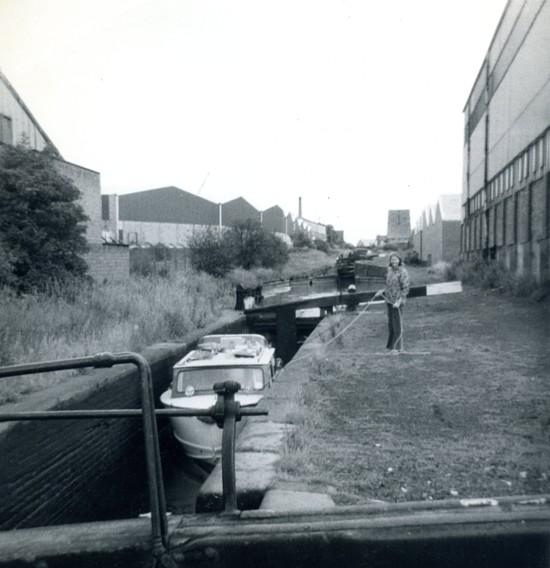
Descending Ryders Green Locks. |
We turned right at Tame Valley Junction and headed for Newton Junction where we turned, having covered the rest of the Tame Valley and Rushall Canals the previous year. The strong wind made turning very tricky, and in the process our prop acquired a long length of very tough string.
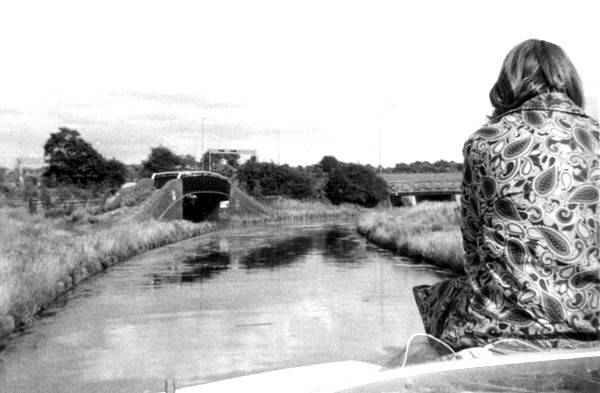
Approaching Newton Junction, where the Rushall Canal leaves the Tame Valley Canal. |
We stopped for the night near Crankhall Lane Bridge, where there were some convenient shops.
Next day we headed onto the Walsall Canal, where thick duckweed and other debris impeded progress. Plastic bags and bits of wood kept fouling the prop, and then there was a clear stretch to Heathfield Bridge where there was a splendid playground for the children.
Eventually we reached the Anson Branch, and headed up it towards the truncated terminus where an M6 junction straddled the canal. We could only get a few feet up the Bentley Canal, and then we approached Bentley Mill Bridge. Headroom here was VERY restricted, due to reinforcing girders underneath the bridge deck. I thought we would get through, and did so, just scraping the last girder with the windscreen. After reaching the culvert under the M6 I stopped to take a photograph.
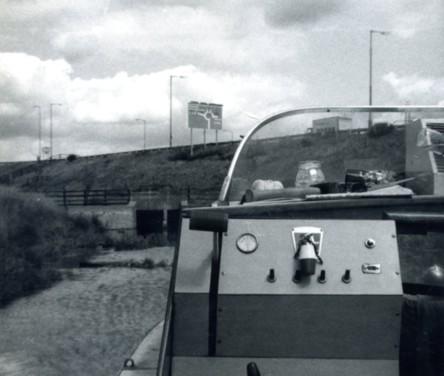
Linton at the end of the truncated Anson Branch where it is culverted under the M6. |
I have since been told that this might be the last recorded occasion when a boat reached the (truncated) end of the Anson Branch by the culvert under the M6, as shortly after our visit it was closed to navigation due to the threat of subsidence.
We then turned around and headed back towards Bentley Mill Bridge. This time the tide had come in (?!) and we were an inch higher, with the result that the windscreen disintegrated. Ooops. I had been far too cautious approaching the bridge and gone into reverse, lifting the boat up as it drew water under the boat. I wonder whether we would have got through more easily if I had opened up the throttle rather than trying to stop, but that is counter-intuitive.
After running repairs and lunch we continued on. There was a total weed block under the office block that crossed the canal at IMI's James Bridge Copper Works. The rest of the canal was fairly clear, and at Walsall Junction we turned right to the basin, although there were a number of underwater obstacles there.
We followed a BWB boat up the Walsall lock flight. They were very considerate, and left half a paddle open at each lock so that it was ready for us.
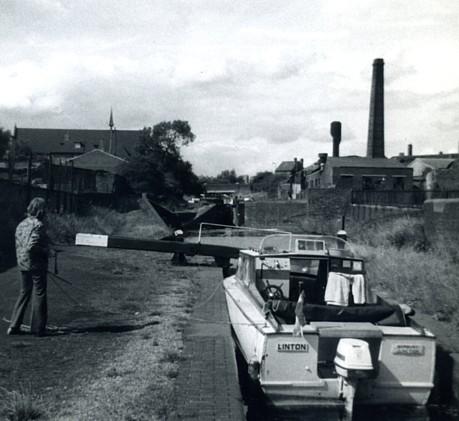
Linton ascending the Walsall flight. |
After reaching the top we headed towards Wolverhampton, meeting three boats and picking up a record number of plastic bags before we stopped for the night on the Bentley Canal above the top lock.
That evening I walked down the flight of six locks that were still technically navigable. A few day-boats were in use a couple of pounds down, and the paddle gear spindles had been removed to prevent vandalism and discourage their use. The Section Inspector later told me that he would have refitted them if we wished to go down, but it would have been foolhardy to descend those locks in a wooden boat because of the rubbish in them. The navigation was closed at the bottom of the bottom lock, and that one certainly looked unuseable. The whole flight has since been demolished
Next day it was raining steadily, and we had the Wolverhampton Flight once again. Another cruiser, Landless, caught us up at Lock 8, and so we made a fast descent in only 2h 8m. Only one other boat passed us on the way up. I noted in the log that BWB had now painted lock numbers on the gates which made it much less confusing.
That afternoon (13th August) we arrived back in Norbury, having covered 385 miles and 236 locks (83 wide) and used 49 gallons of petrol.
It was after this trip in a boat with very low cabin headroom and three children that Hazel insisted that we bought a bigger boat. The new Linton was no longer (19 ft), but at least we could stand up inside!
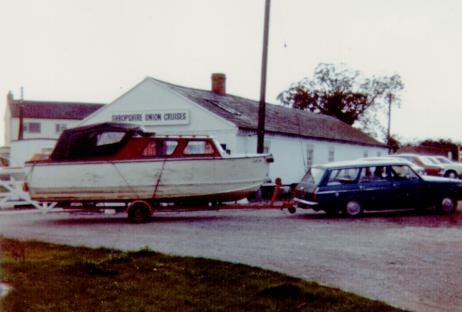
The first 'Linton' being trailed away from Norbury Junction after our last trip in her (22nd September 1974). |
In the 15 months that we owned her, the first 'Linton' took us through 680 locks and a total distance of 1290 miles, covering 475 miles of England's waterways network.
1 - On the way to Stratford and back, August 1973
2 - Stourbridge Arm & Dudley Tunnel, October 1973
3 - Titford Pools and the Return to Coombeswood, June 1974
5 - Stourbridge Re-visited, May 1975
6 - An Autumnal Trip - The Body and the Tunnel, October 1975
7 - Exploring Unvisited Branches, June 1977
Main Index Page
BCN Index Page